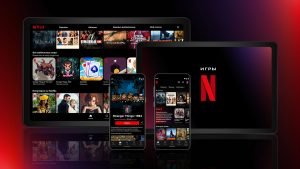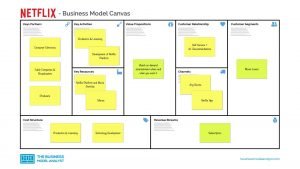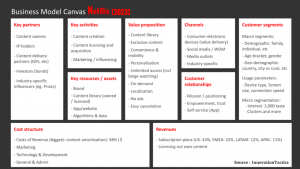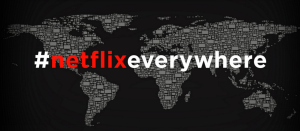2023 Business Model of Netflix
- Netflix was founded in 1997 by Reed Hastings and Marc Randolph in a small California city called Scotts Valley in Santa Cruz county. Reed Hastings has said the idea was sparked by a $40 fine he got for renting the movie Apollo 13 from long-dead Blockbuster and returning it six weeks late.
- The US-based video business was called Kibble before the name was changed to NetFlix.com, and later Netflix. It began renting DVD rentals by mail in April 1998 and introduced its subscription model the following year
- In 2003, Netflix was issued a patent by the U.S. Patent & Trademark Office to cover its subscription rental service and several extensions. Netflix posted its first profit in 2003, earning $6.5 million on revenues of $272 million; by 2004, profit had increased to $49 million on over $500 million in revenues.
- 2007-2012: Streaming Video Hits the Mainstream, DVD Bites the Dust. 2007 was a huge year for Netflix. Although Netflix’s DVD business was growing rapidly, the company decided to permanently transform the business by launching its first streaming product, Watch Now.
- The first disc ever shipped from Netflix was Beetlejuice starring Geena Davis, Michael Keaton, and Alec Baldwin
- Netflix reached a whopping 15.8 million paid subscribers in the first three months of 2020 amid the coronavirus pandemic which has forced people to stay at home. The California-based company had expected 7.2 million subscribers but witnessed a more than double rise in paid subscribers
In 2002, Netflix stock was opened with an Initial Public Offering at $1 per share on NASDAQ under the ticker NFLX, and the all-time high Netflix stock closing price was $691.69 on November 17, 2021 & now the price is $289.57 on October 21, 2022

Journey of Netflix
In 1997 when Reed Hastings and Marc Randolph founded Netflix, no one ever imagined that by 2020 it would register an annual revenue worth $24.99 billion. The US-based startup became one of the biggest TV and movie studios globally in just 24 years, with more subscribers than all the US cable TV channels. Let’s turn back the pages; in 1997, Netflix was founded as a $2.5M trifling startup. What people expected from a staff of nearly ten people was nothing bigger than a meager profit. But today’s story is different since Netflix has successfully conquered the largest share of filmed entertainment with a base of more than 7,000 employees and 158 million subscribers. What is more surprising is the fact that Netflix is able to retain its subscriber base despite charging the highest over-the-top (OTT) service rates in the country (almost double the rates of local competitors). People around the world stream 125 million hours of content on Netflix every day.
According to Forbes Report published in September 2019, Netflix is the world’s fourth-best-regarded company after Visa, Ferrari, and Infosys and the first in the category of Internet Catalog Retail with a market cap of $157.3B.
For any entertainment business, it is difficult to beat the challenges of fast-growing technology, heavy demand, and fluctuating internet traffic. But statistics indicate that Netflix had to come up with dynamic strategies and smart solutions to penetrate the internet market. Forbes stated that Netflix operates its business through domestic streaming, International streaming, and Domestic DVD. It collects content from various content providers through fixed-fee licenses, revenue-sharing agreements, and direct purchases. It hosts its service through various channels, including online advertising, television, radio, and various partnerships.
Netflix carried out its journey of experiments and challenges to reach where it is today. Here are some methodologies that worked for Netflix to create a vast niche.
- Adoption of Subscriber-based Model
- Ads-free Content
- Content Personalization
- Video Streaming
- Fast globalization
- Device-Optimized Content
- Creating Fascinating Content
- Chaos Engineering
The Preliminary Business Model of Netflix
When software engineers Reed Hastings and Marc Randolph founded Netflix in 1997, that time video rental stores dominated the home entertainment market. People like to watch movies at that time, but Reed Hastings observed and thinks ‘how can we make it more convenient?’ From this thought, the seed of Netflix was already in the making, but things were not easy for him to initially change the audiences’ mindset; he did not change the whole procedure. He decided to do rentals in a whole new manner, and Netflix began renting out DVDs by mail in April 1998, which turned out to be a game-changer in the video-renting market. At that time, VHS dominated the market, and only 2% of American households owned DVD players. And by that time, Reed and Rudolph knew if they captured the market by 20 percent of the household, it would be a victory for them.

Netflix’s secret weapon wasn’t luck, but they tried to keep analyzing their market. Hastings and Randolph may have built their initial business around DVDs, but they knew they would not stick to the DVD business forever, even if no one else did.
Hasting never wanted to settle down in the DVD renting business; he saw the opportunity to use the internet to decentralize entertainment and give users a new viewing experience with the best in sound and video quality.
DVD rentals were never Netflix’s target – they were on the way for the new company to achieve a tentative foothold in an intensely competitive market.
2023 Business Model of Netflix
2023 Business Model of Netflix

THE JOURNEY OF NETFLIX – TIMELINE
What is the Future of Netflix and Where it Can Go from Here?

Competition from rivals including Amazon Prime and Disney Hotstar will likely intensify in the coming years, but Netflix still has plenty of options like:
- Augmented and Virtual (AR & VR) reality content
- Superior shows, driven by data
Important Lessons Every Startup Should Learn from Netflix
It’s been an interesting ride for Netflix for over 24 years. What can we learn from the company’s journey?
- Identify the one metric that can grow your business
It’s no secret, and we all know that most new businesses fail. Some companies don’t make it because they cannot handle too many risks, but just as many fail because they don’t aim high enough.

It’s crucial to identify a potential market that you can grow into in your business’s early days. Google may be one of the world’s biggest technology companies, but it still cares about how many searches are led every month. Facebook may have 2.5 billion users, but it has always cared about how active those users are and how it can maximize those active users’ engagement. In short, what we mean to say is never relax; always target what you have aimed for.
- Palpable moves aren’t necessarily dumb moves
Just because the audience expects your business to do something doesn’t mean it’s the wrong thing to do.
Not every idea has to reinvent the wheel. The best decisions are the ones that help your business to flourish, not the ones that only keep your competitors on their toes.
`
However, that’s not to say that the best moves are always obvious. In Netflix’s case, the decision to start streaming video through the internet was the bold decision ever made by a company. But at the time, Hastings’ decision cast doubt on both his leadership and the company’s future. Suppose Hastings had listened to the Naysayers (a person who criticized) who thought streaming was nothing more than a fad. Where would Netflix be today?
- Focus relentlessly on quality
Netflix has always focused on doing something extraordinary with future technology, whether providing a DVD rental business or developing new streaming technologies.

This dedication to quality – whether it be the quality of the Netflix experience or the quality of its content – is what has helped Netflix cultivate not only a vast subscriber base but a loyal audience of fans.
Although there are exceptions, it’s generally safe to assume that the higher the quality of your product or service, the higher your costs will be. However, depending on how competitive your vertical is, the question may not be whether you can afford to make a higher-quality product but whether you can afford not to.
Considering the above facts about Netflix’s approach to making a strong footing in the streaming business, it seems the company has even more potential to unfold for expanding its audience base. The strategies and business models can become an inspiration for related marketers to help their businesses grow to greater heights.
